
(a)
Interpretation: The structure of the major product formed from alkene indicated should be predicted.
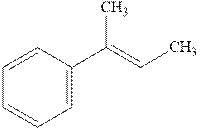
Concept introduction: Hydroboration-oxidation involves the sequence of two reactions. The hydroboration stage involves the treatment of alkene with diborane that generates alkyl borane. In second stage hydrogen peroxide in alkaline medium is used to oxidize the alkyl borane produced in step 1 that leads to the synthesis of alcohols from
Hydroboration is essentially the addition of
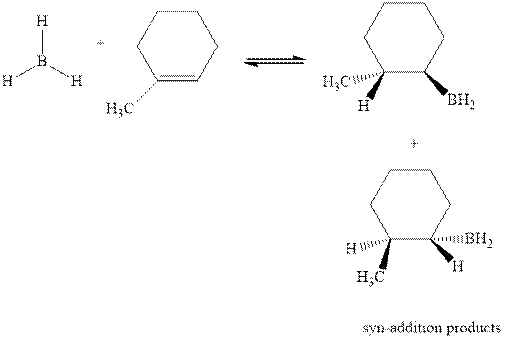
The mechanistic pathway can be illustrated as follows:
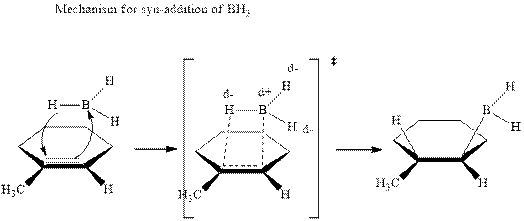
In the first step one equivalent of
(a)
Explanation of Solution
The hydroboration-oxidation productis illustrated as below.

Anti-Markovnikov’s Rule serves as the basis of hydroboration. It states that the negative part of reagent must go to the carbon that has fewer alkyl substituents or more
(b)
Interpretation: The structure of the major product formed from alkene indicated should be predicted.
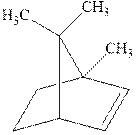
Concept introduction: Hydroboration-oxidation involves a sequence of two reactions. The hydroboration stage involves the treatment of alkene with diborane that generates alkyl borane. In second stage hydrogen peroxide in alkaline medium is used to oxidize the alkyl borane produced in step 1 that leads to the synthesis of alcohols from alkenes.
Hydroboration is essentially the addition of

The mechanistic pathway can be illustrated as follows:
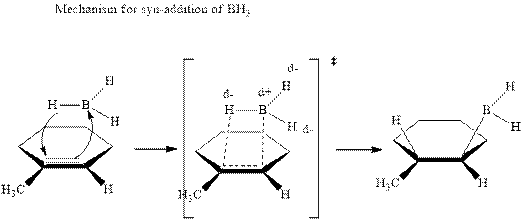
In the first step one equivalent of
(b)
Explanation of Solution
The hydroboration-oxidation product is illustrated as below.

Anti-Markovnikov’s Rule serves as a basis of hydroboration. It states that the negative part of reagent must go to the carbon that has fewer alkyl substituents or more
(c)
Interpretation: The structure of the major product formed from alkene indicated should be predicted.

Concept introduction: Hydroboration-oxidation involves a sequence of two reactions. The hydroboration stage involves the treatment of alkene with diborane that generates alkyl borane. In second stage hydrogen peroxide in alkaline medium is used to oxidize the alkyl borane produced in step 1 that leads to the synthesis of alcohols from alkenes.
Hydroboration is essentially the addition of

The mechanistic pathway can be illustrated as follows:
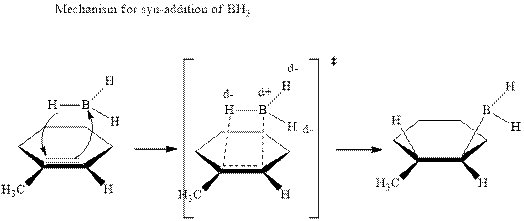
In the first step one equivalent of
(c)
Explanation of Solution
The hydroboration-oxidation product is illustrated as below.

Anti-Markovnikov’s Rule serves as the basis of hydroboration. It states that the negative part of reagent must go to the carbon that has less alkyl substituents or more
Since the terminal olefinic carbon is less substituted
(d)
Interpretation: The structure of the major product formed from alkene indicated should be predicted.

Concept introduction: Hydroboration-oxidation involves a sequence of two reactions. The hydroboration stage involves the treatment of alkene with diborane that generates alkyl borane. In second stage hydrogen peroxide in alkaline medium is used to oxidize the alkyl borane produced in step 1 that leads to the synthesis of alcohols from alkenes.
Hydroboration is essentially the addition of

The mechanistic pathway can be illustrated as follows:
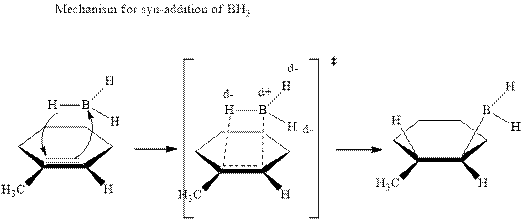
In the first step one equivalent of
(d)
Explanation of Solution
The hydroboration-oxidation product is illustrated as below.
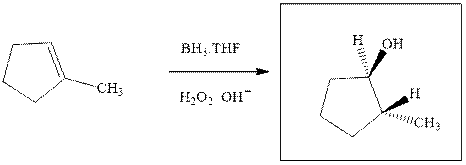
Anti-Markovnikov’s Rule serves as the basis of hydroboration. It states that the negative part of reagent must go to the carbon that has less alkyl substituents or more
(e)
Interpretation: The structure of the major product formed from alkene indicated should be predicted.

Concept introduction: Hydroboration-oxidation involves a sequence of two reactions. The hydroboration stage involves the treatment of alkene with diborane that generates alkyl borane. In second stage hydrogen peroxide in alkaline medium is used to oxidize the alkyl borane produced in step 1 that leads to the synthesis of alcohols from alkenes.
Hydroboration is essentially the addition of
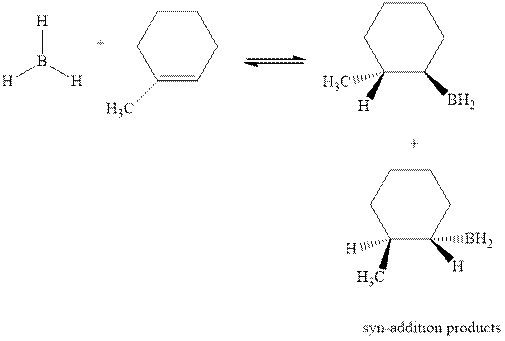
The mechanistic pathway can be illustrated as follows:

In the first step one equivalent of
(e)
Explanation of Solution
The hydroboration-oxidation product is illustrated as below.

Anti-Markovnikov’s rule serves as the basis of hydroboration. It states that the negative part of reagent must go to the carbon that has less alkyl substituents or more
Want to see more full solutions like this?
Chapter 10 Solutions
EBK EXPERIMENTAL ORGANIC CHEMISTRY: A M
- 11.; (a) Similar to alkanes, hydrogen gas can undergo radical bromination according to the reaction below. Propose a chain-reaction mechanism for this reaction, including an initiation step, propagation steps, and two plausible termination steps. The homolytic bond dissociation energy for Br-Br is 46 kcal·mole', for H-Br is 88 kcal'mole and for H-H is 104 kcal'mole'. hv H-H + Br-Br 2 H-Br (b) Calculate the overall AH for the above propagation steps (show all work).arrow_forwardElimination of HBr from 2-bromobutane affords a mixture of but-1-ene and but-2-ene. With sodium ethoxide as base, but2-ene constitutes 81% of the alkene products, but with potassium tert-butoxide, but-2-ene constitutes only 67% of the alkene products. Offer an explanation for this difference.arrow_forwardAs the molecular weight of alkenes increases, the boiling points also increase. Which ofthe following factors is best associated to this trend? *Dipole interactionGeometric isomerismStructural isomerismSurface areaA radical substitution reaction is primarily observed in the following reactions. Whichreaction is it? *Oxidation of but-2-eneChlorination of butaneBoiling of hex-3-eneCombustion of methaneWhich among the following compounds has the most electronegative carbon in itsstructure? *ButyneBenzeneBenzaldehydeCyclobutanearrow_forward
- Bromine reacts with alkenes in methanol according to the equation: - When this reaction was carried out with 4-tert-butylcyclohexene, only one isomer was formed with the molecular formula C12H23BrO (80% yield). Which of the following is the structure more reasonable for this compound?. Explain your reasoning through acorresponding mechanism.arrow_forwardThe hydroboration–oxidation of internal alkynes produces ketones.(a) When hydroboration–oxidation is applied to but-2-yne, a single pure product isobtained. Determine the structure of this product, and show the intermediates in itsformation.arrow_forwardAlkenes can be converted to alcohols by hydroboration-oxidation. (a) Draw the structure of the alcohol or alcohols formed in the reaction sequence. Clearly indicate stereochemistry by drawing a wedged bond, a dashed bond and two O Hint in-plane bonds per each chiral carbon. Draw hydrogen atoms that are connected to wedge-and-dash bonds.(b) Characterize the product or products of the reactions. The first step of the reaction, hydroboration, involves addition of BH, to the double bond, with -BH, attached to one carbon and hydrogen Be sure to draw hydrogens on oxygen, where applicable. attached to the other. Consider both Rings the regioselectivity and the Select Draw More Erase stereochemistry of this addition. H Diborane, B,H,, is a source of borane, BH,, and can be used 1. B2H6, interchangeably. Diglyme is a solvent. diglyme 2. H2О2, НО", The product or products of the reaction are characterized as being O S. O racemic. O achiral. O R,S (and/or S,R). O R. O S,S. O R.R. O diastereomers.arrow_forward
- What is(are) the product(s) of the following hydroboration-oxidation reaction? Include stereochemistry.arrow_forwardPredict the maior products of both organic reactions. Be sure to use wedge and dash bonds to show the stereochemistry of the products when it's important, for example to distinguish between two different major products.arrow_forwardThe rate law for addition of Br2 to an alkene is first orderin Br2 and first order in the alkene. Does this informationsuggest that the mechanism of addition of Br2 to analkene proceeds in the same manner as for addition of HBr?Explain.arrow_forward
- Write the mechanism(s), major product(s), and stereochemistry(ies) for each of the following reactions:please do them in the structural form i have themarrow_forwardChemistry 3. Complete the following reaction scheme. Give all product(s) and indicate major or minor and any relevant stereochemistry. (а) NaOEt heat (b) heat (c) Br NaCN DMF (d) (e) OH H,SO,/H,PO, heat (f) HBr (g) 1) BH. THE 2) H,0, OH (h) 1) Hg(OAC), H-0 2) NaBH, (i) KMNO, NaOH Coldarrow_forwardWhat is(are) the product(s) in the Pd-catalyzed hydrogenation of 1,2-dimethylcyclopentene? Include stereochemistry.arrow_forward
 Organic ChemistryChemistryISBN:9781305580350Author:William H. Brown, Brent L. Iverson, Eric Anslyn, Christopher S. FootePublisher:Cengage Learning
Organic ChemistryChemistryISBN:9781305580350Author:William H. Brown, Brent L. Iverson, Eric Anslyn, Christopher S. FootePublisher:Cengage Learning
